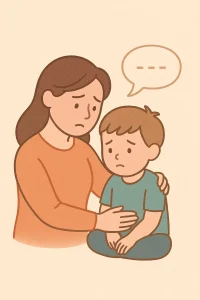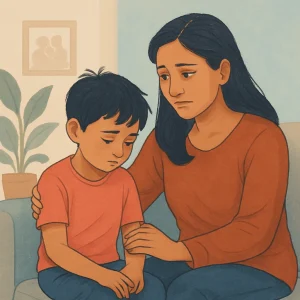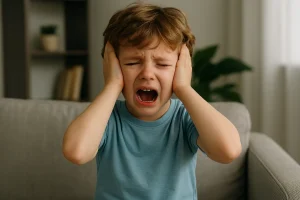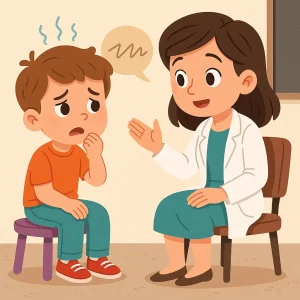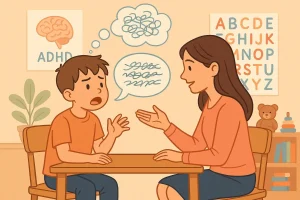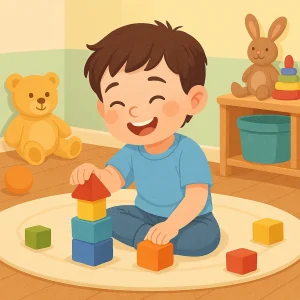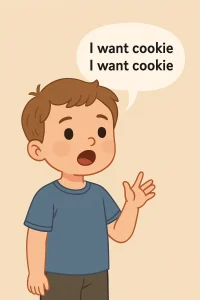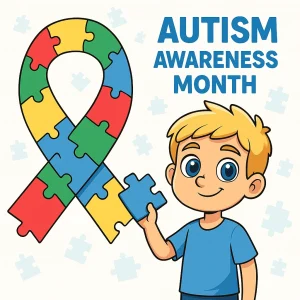Cluttering in the Classroom: How Teachers Can Make a Difference
By Rajini D
Last Updated: April 8, 2025
Cluttering, a lesser-known yet impactful speech disorder, can profoundly affect an individual’s ability to communicate effectively. It is characterized by a rapid and irregular speech rate, excessive filler words, and frequent pausing, making it difficult for listeners to understand. Unlike stuttering, cluttering leads to significant challenges in academic and social settings, especially for students. Supporting students with cluttering involves understanding these unique communication hurdles and implementing strategies to enhance their ability to express themselves clearly and effectively in both school environments and beyond.
In educational environments, where communication plays a critical role in learning and interaction, the support of informed and proactive teachers is crucial. Teachers equipped with the right strategies and knowledge can make a monumental difference in the educational experiences of students with cluttering. They serve not only as educators but as pivotal supporters who can foster a nurturing learning environment that accommodates all students’ needs. This support is vital not just for academic success but also for building students’ confidence and social skills, which are equally important for their overall development.
Understanding Cluttering in Students
What is Cluttering?
Cluttering is a fluency disorder that is often misunderstood or overlooked. It is characterized by a rapid and erratic speech rate, which often leads to excessive pauses, abbreviations, and disruptions in speech flow. This can make speech difficult to follow or understand. Unlike stuttering, where the struggle to speak is noticeable, cluttering is more about the delivery being jumbled or excessively filled with fillers, making it seem as though thoughts are not well-connected.
People who clutter might not even be aware of their speech disorganization, as they typically do not experience the physical tension associated with stuttering. This can include speaking in bursts, or stopping unexpectedly, leading to uneven and choppy sentences. Such patterns are not just a challenge for the speaker but also for listeners trying to keep pace with or interpret the rapid delivery of words.
Also read: Cluttering Speech Explained: Causes, Symptoms and Help
Impact of Cluttering on Learning
Cluttering can significantly impact a student’s performance in the classroom. Academically, it may affect their ability to participate in discussions, deliver oral presentations, and can sometimes be mistaken for a lack of preparation or knowledge. Socially, it can lead to misunderstandings and frustrations among peers, potentially isolating the student.
In the classroom setting, students with cluttering may struggle with:
- Following multi-step instructions: Their processing speed may not align with how quickly they speak, leading to missed details.
- Participating in oral exams and discussions: They may avoid speaking due to fear of being misunderstood or not being able to adequately express their thoughts.
- Group work: Interaction challenges can hinder their ability to collaborate effectively.
Know more about our article on How Does Cluttering Impact Academic Performance?
Classroom Strategies for Supporting Students with Cluttering
Create a Supportive Classroom Environment
Creating a supportive classroom environment is essential for all students, particularly those with cluttering issues, as it can significantly enhance their ability to learn and communicate. Here are some tips for fostering a patient and understanding classroom atmosphere:
- Promote an Inclusive Culture: Encourage inclusivity by educating the class about different learning and communication styles. This promotes empathy and understanding among peers.
- Establish a Patient Communication Norm: Set clear expectations for communication, such as waiting for a person to finish their thoughts before responding, which helps students with cluttering speak without feeling rushed or judged.
- Encourage Open Dialogue: Create a classroom culture where students feel safe to express their needs and preferences, including the challenges they might face with cluttering.
- Adapt Physical Spaces: Arrange the classroom to facilitate easier communication. This might include seating arrangements where students face each other to facilitate lip-reading and non-verbal cues.
- Highlight Strengths: Focus on and celebrate what each student does well. Recognizing strengths beyond verbal communication can boost confidence in students with cluttering.
Speech Therapy Techniques in School Settings
Incorporate Speech Exercises into Daily Routines
Integrating speech therapy exercises into daily classroom routines can be a game changer for students with speech disorders like cluttering. Here are some simple techniques that can be seamlessly included in everyday activities:
- Morning Check-ins: Start the day with a brief check-in where students share how they are feeling or a fun fact about their morning. This routine helps students with cluttering practice structured speech in a supportive setting.
- Story Recaps: After a reading session, ask students to summarize the story in their own words. This encourages them to organize their thoughts and convey them clearly.
- Role-playing Exercises: Incorporate role-playing into social studies or reading lessons, where students can practice dialogues or debates. This provides a real-world context to apply clear speaking techniques.
- Tongue Twisters: Use tongue twisters as a fun group activity. They are excellent for practicing articulation and can be a light-hearted way to start or end a lesson.
- Descriptive Exercises: Have students describe a picture or an object using detailed sentences. This helps them focus on the flow of their speech and the clarity of their descriptions.
Collaborate with Speech Therapists
Partnering with speech therapists can bring specialized knowledge and techniques into the classroom, tailored specifically to support students with speech disorders. Here’s how collaboration with speech therapists can benefit the educational setting:
- Customized Support Plans: Speech therapists can develop individualized support plans for students, addressing specific needs and setting achievable goals, which teachers can then reinforce during classroom activities.
- Professional Development: Therapists can provide training and resources to teachers, helping them understand speech disorders better and equipping them with strategies to support all students effectively.
- Enhanced Learning Materials: By working together, teachers and therapists can create materials that integrate speech therapy into learning content, such as phonetically balanced reading texts or interactive speech games.
- Ongoing Assessment and Feedback: Regular collaboration allows for ongoing assessments of students’ progress and adjustments to their learning plans, ensuring that the strategies remain effective over time.
- Family Involvement: Speech therapists often involve families in the therapy process. Their collaboration with schools can extend this practice, helping to create a consistent support network between home and school.
Ready to enhance your child’s speech? Visit Our Online Speech Therapy for Kids and start their journey to clearer communication today!
Enhancing Classroom Interaction
Encourage Peer Support
Creating a supportive classroom environment includes fostering strong peer relationships. Peer support is particularly beneficial for students with cluttering, as it encourages communication within a less formal, more forgiving setting. Here are some ways to build peer mentoring opportunities that can assist students with cluttering:
- Buddy Systems: Pair students with peers who show empathy and patience. These buddies can help by modeling clear communication and offering gentle reminders to slow down or rephrase when needed.
- Group Projects: Design group activities that require various roles, allowing students with cluttering to contribute in ways that play to their strengths while practicing communication skills in a supportive environment.
- Peer Feedback Sessions: Implement structured feedback sessions where students can present to small groups and receive constructive feedback in a controlled, supportive setting.
- Communication Circles: Regularly organize communication circles where students share stories or discuss topics of interest. This practice builds speaking confidence in a group setting.
- Role-playing Activities: Use role-playing to simulate real-life interactions, which can help students with cluttering practice speech patterns and social cues in a safe environment.
Monitoring Progress and Adapting Strategies
Regular Check-Ins with Students
Regular check-ins with students are vital in adapting teaching methods to meet individual needs, especially for those with cluttering. These ongoing assessments help teachers monitor progress and fine-tune their strategies to optimize learning outcomes. Here’s how regular check-ins can play a crucial role in education:
- Identifying Progress and Challenges: Regular discussions with students allow teachers to gauge their comfort with the material and identify any new challenges that arise.
- Adjusting Teaching Methods: Based on feedback from these check-ins, teachers can modify their instructional approaches. For instance, if a student struggles with certain speech exercises, a teacher might introduce alternative methods that could be more effective.
- Setting Goals: These meetings are an excellent opportunity for setting short-term goals with students, which can motivate them and provide clear benchmarks for success.
- Enhancing Student Engagement: Check-ins show students that their progress is important and that their educators support them. This can increase their engagement and willingness to participate in class.
Conclusion
Teachers play a key role in helping students with cluttering excel both academically and socially. By embracing and tailoring classroom strategies—like using visual aids, encouraging peer support, and integrating speech therapy techniques—educators can create a more inclusive and supportive environment. It’s important to continuously adapt these methods based on feedback from students and parents to ensure every student thrives. For additional resources and practical tips, explore Wellness Hub, your partner in educational support. Together, we can make learning accessible and engaging for every student.
Frequently Asked Questions:
1. What is cluttering in speech?
Cluttering is a fluency disorder characterized by a fast speaking rate that can make speech sound rushed and difficult to understand. Individuals with cluttering may also add unnecessary words or phrases and have disorganized speech that can confuse listeners. The disorder differs from stuttering, as it doesn’t usually include physical tension or struggle with starting words.
2. How can teachers help students with cluttering?
Teachers can assist students by speaking slowly and clearly, providing written instructions to complement what they say aloud, and using visual aids to reinforce spoken words. Creating a patient and supportive classroom environment that encourages participation without fear of judgment is also crucial. Teachers might also include specific speech therapy techniques into classroom activities to help improve clarity in speech.
3. What are some simple classroom strategies for cluttering?
Effective classroom strategies for cluttering include breaking tasks into smaller, manageable steps, using visual schedules to outline daily activities, and employing apps or tools that focus on improving speech pacing. Additionally, role-playing and peer mentoring can provide real-life practice and feedback in a supportive setting.
4. Why is peer support important for students with cluttering?
Peer support helps build a nurturing environment where students feel accepted and understood. It can increase a student’s confidence and encourage social interaction, which is vital for developing better communication skills. Peers can also serve as positive role models, demonstrating proper speech pacing and clear communication.
5. Can technology help students with cluttering?
Yes, technology can be highly beneficial for students with cluttering. Tools like speech-to-text software can help students articulate their thoughts without the pressure of speaking in real-time. Educational apps that focus on speech pacing and clarity can also provide practice in a fun, engaging format.
6. What role do regular check-ins play in supporting students with cluttering?
Regular check-ins allow teachers to monitor a student’s progress, adjust educational strategies as needed, and provide consistent support. These meetings can help identify which methods are working or if new techniques should be tried, ensuring that the educational approach remains personalized and effective.
7. How can feedback from parents improve support for children with cluttering?
Parental feedback is invaluable as it can provide insights into what strategies are effective at home and might also work well in the classroom. Parents who share observations about their child’s communication challenges and successes can help teachers tailor their approaches to better meet the child’s needs.
8. What are some signs that a child might be cluttering their speech?
Signs of cluttering include excessively fast speech, frequent hesitations, unnecessary fillers, and jumbled words. A child might also show difficulty in organizing their thoughts during speech, making it hard for listeners to follow along.
9. Where can I find more resources on helping my child with cluttering at school?
Wellness Hub offers a variety of resources for parents and educators on supporting students with cluttering and other speech disorders. Their website provides access to articles, therapy techniques, and educational tools designed to enhance learning for students with communication challenges. Visit Wellness Hub for more information.
10. How can I work with my child’s school to support their cluttering issues?
Start by maintaining open lines of communication with your child’s teachers and speech therapists. Regular meetings and updates can help ensure that everyone is on the same page regarding strategies and progress. Sharing successful techniques from home and learning about new methods used at school can foster a consistent approach that supports your child’s development.
About the Author:
Rajini Darugupally
M.Sc., Speech-Language Pathologist (9+ years of experience)
Rajini is a passionate and dedicated Speech-Language Pathologist with over 9+ years of experience, specializing in both developmental speech and language disorders in children and rehabilitation in adults. Driven by a desire to empower each individual to find their voice, Rajini brings a wealth of experience and a warm, genuine approach to therapy. Currently, at Wellness Hub, she thrives in a team environment that values innovation, compassion, and achieving results for their clients.
Book your Free Consultation Today
Parent/Caregiver Info:
Client’s Details:
* Error Message
